It’s tough being a girl in comic books. You don’t have a lot of options. The big divide is between being a superhero or a mundane, but that’s just physics. In reality your choices aren’t based in whether or not you have any powers but what kind of woman you are.
You can be the Romantic Love Interest—with the option of becoming the Wife if you can convince the hero to stick around or, if he dumps you, the Femme Fatale/Villain. If you are a Career Woman, you usually only do that while biding your time until the hero proposes or dumps the Sexy Girl. The Sexy Girl exudes sexuality and seduces other characters left and right. She functions under what should be sex positive behavior but is generally treated by the creators as a chance to get a woman as close to naked on the page as they can. She wears nothing but bikinis, revealing costumes so tight they look painted on, or outfits perpetually coming undone. Sometimes you can be the Lesbian, but most of the time that’s just an excuse for the writers to have you talk about all the sex you’re having and for the artist to draw you in a variety of titillating poses. In other words, you’re the Sexy Girl with slightly different window dressing.
Word of warning: the Sexy Girl never gets to keep the hero. He will dump her for the Wife which will force you to become the Femme Fatale/Villain, or the writers will force you to abandon your slutty ways and become the squeaky clean Wife…who will eventually get her heart broken when the hero dumps her anyway. Because the hero always dumps the girl. If, by some miracle, the hero doesn’t dump you (or just hasn’t gotten around to it yet), then you get to choose between betraying him or getting fridged all to give the hero motivation to keep doing his fucking job. If you’re a woman of color or LGBTQIA+ not only do you have to be one of the female tropes, but probably a racist/homophobic one as well. And don’t even get me started on QWoC.
Things aren’t all bad, though. There are a few gems in the dung heap of sexist stereotypes and misogynistic plots, and comics are definitely improving, albeit incrementally. The problem is, for every woman on this list there are a dozen Scott Lobdell Starfires and Rob Liefeld Glorys, and no amount of Hawkeye Initiative submissions can rectify that. Even if a new creative team tries to shed all the nastiness from the past, a variant cover will turn up and set the clock back again (case in point: those Spider Woman and Batgirl covers completely at odds with the issue’s target demo and thematic tone).
But I don’t want to focus on the negative. Let’s talk about some awesome chicks. This is a roundup of 10 groups of women who have made my comics life worth living. Like last month’s Black History Month post, I’m sure there are a ton of women that you think I should’ve included but didn’t, and I want to hear from you in the comments. There are few superheroes on this list for two reasons: point the first, I’m saving some for roundups on Asia-Pacific Heritage and Pride Months; point the second, because too many female superheroes come with all the aforementioned misogynistic baggage—I means, just look at what the Finches have done to Wonder Woman, for Hera’s sake. If you’re the kind of person who, as the great Leslie Knope once said, objects to powerful depictions of awesome ladies, then this post ain’t for you. For the rest of us, let’s talk about some fantastic comic book women who have overcome the challenges of their tricky medium.
April, Jo, Mal, Molly, and Ripley
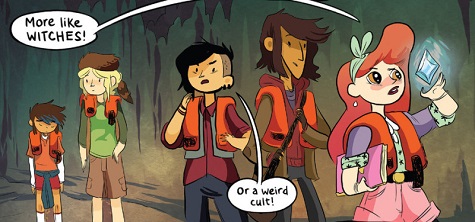
Alias: Lumberjanes
Creators: Brooke A. Allen, Grace Ellis, Noelle Stevenson, Shannon Watters
Origin: Lumberjanes #1, 2014, Boom! Box
If you’re looking for a comic book full of great, diverse girls, you can’t go wrong with Lumberjanes. I could tell you that I love this series so hard it makes my heart hurt, that I look forward to each issue like a kid at Kwanzaa, and that I am way more emotionally invested in Mal and Molly’s relationship than is probably healthy for a 31 year old. I could tell you all that, but I already have in a much longer and much more effusive post than what you’re getting in these two short paragraphs. Point is, the Lumberjanes are awesome. I wish I’d gotten to go to a camp as cool as Miss Quinzella Thiskwin Penniquiqul Thistle Crumpet’s Camp for Hardcore Lady Types. I would’ve been much happier there than in the über-fundie scout camp I was stuck in as a kid, if for no other reason than I’d get tattooed Rosie as my scout master.
There are so, so, so many reasons the Lumberjanes make wonderful role models for young girls. The girls use influential women as interjections (“Holy bell hooks!”). They are never sexualized, degraded, or fridged just because the writers need a plot device to inspire a man. The scout camp is crazy diverse, and no one is ever othered for their appearance, orientation, ethnicity, or anything else. Even the not-so-nice goddess who keeps tangling the girls up in her family’s shenanigans is never treated poorly or hated on by the rest of the camp. Best of all, the whole camp is infused with undying optimism, dedicated feminism, and earnest determination. Not since Leslie Knope have I seen such a belief that even when things get dire, you can overcome anything with friendship and politeness.
Betty, Dee, Hannah, and Violet
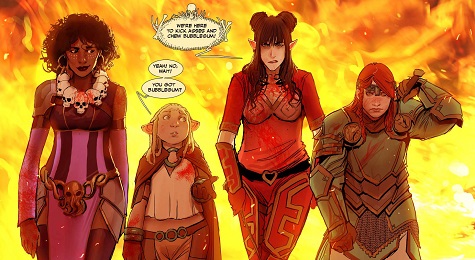
Alias: Rat Queens
Creators: Kurtis J. Wiebe, Roc Upchurch
Origin: Rat Queens #1, 2013, Image
The best way I can think to describe the Rat Queens is like if someone dropped a gang of roller derby girls into Dragon Age and added a hefty dose of drugs and sex. They are the Millennial version of a less crass, more hipster Tank Girl. Betty is the drugs ‘n’ candy obsessed Smidgen thief, Dee is the atheist cleric sorcerer with a god hot on her tail, Hannah is a rockabilly witch with a short fuse, and Violet is a beardless dwarf with more guts than most soldiers. Together, the women wander the countryside knocking heads and boots.
I never thought I’d compare Lumberjanes and Rat Queens because their tones are just so different, but the two things they do have in common (besides a supernatural plot) are the diversity of characters and the supportive affection the girls have for each other. They may not always agree, and sunny positivism ain’t exactly their jam, but they’ll never leave one another behind. They are besties in the best sense. Rat Queens is pretty much the greatest thing to happen to women in the Sword and Sorcery subgenre since, well, ever.
Felicity Smoak
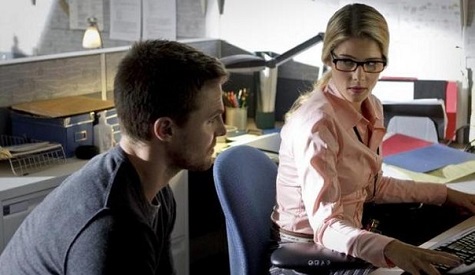
Creators: Gerry Conway, Rafael Kayanan
Origin: The Fury of Firestorm #23, 1984, DC
There is a comic book version of Felicity Smoak, but I have less than zero interest in her. This is about Felicity from Arrow. Any episode in which she doesn’t appear is vastly less interesting. Emily Bett Rickards’ Felicity is sharp and quick, but never clichéd. She zooms past every trope they throw at her with a flirty smile and a trail of mind-boggling hacker whatsits in her wake. Felicity and Oliver—and Rickards and Stephen Amell—have the kind of chemistry rarely seen. Their genuine affection and compassion makes every Olicity scene sparkle and spark. She understands him better than he does, and her refusal to let him lie to her is why they aren’t together at the moment. She won’t accept anything less than his true self because she knows they both deserve honesty. Ollie never exploits her skills, and she always calls him on his bad behavior.
Felicity get by just fine without Oliver, but he falls completely apart without her. Oliver can’t seem to remember how to be human instead of a killing machine if he doesn’t have Felicity to keep him straight, but Felicity is her own complete person with or without him. And to top it all off, she gets to be kick ass without actually kicking ass. She can fight when she has to, but she’s better at strategizing her way out of a pickle. She’s very girly, but she dresses the way she wants because it makes her happy, not because she wants Oliver—or Ray—to think she’s hot. She is a nerdy, obsessive, straight-talking, confident woman who doesn’t sacrifice her femininity or catfight with the other women around her. TBH, Arrow’s Felicity is a better hero than the star.
Katherine “Kate” Corrigan
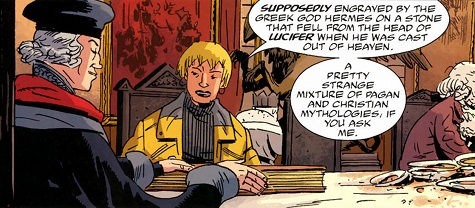
Creators: Mike Mignola
Origin: Hellboy: The Wolves of St. August, 1994, Dark Horse
Kate is a former history professor turned Bureau for Paranormal Research and Defense Special Liaison to Enhanced Talent Agents. In 1984 she joined the BPRD after getting to know Hellboy during a consultancy gig. Using her encyclopedic knowledge of folklore and the paranormal, she assists the agency with solving challenging cases. Kate has written 16 books—not counting her unpublished monograph about Hellboy himself—and is a distinguished and highly respected academic in her field. She’s been captured and nearly killed many times over the years, but she never lets that stop her from doing her job and saving the world. In “The Universal Machine,” Kate rescues herself using her smarts and willpower, rather than waiting around for the dudes to show up. Plus, her character design was based on Mignola’s wife. So romantic!
Prof. Corrigan wasn’t on the main roster until the BPRD series “Plague of Frogs” in 2004. Before that she popped up every now and then to relay some crucial bit of info and disappeared again. But over the years she’s become more and more integral to the agency and the series. The movie casts pyrokinetic Liz Sherman as Hellboy’s closest friend and confidante, but anyone who’s read the comics knows the woman who really holds that role is Kate. After Hellboy learns of his hell-bound fate, it’s Kate he reveals his secrets to, and it’s Kate who convinces him to face his fears rather than hide from them like he always does. While he went on a walkabout to find his place in the universe, Kate got promoted and now acts as an advisor to pretty much everyone at BPRD. Not only is she brilliant, but she’s thoughtful, honest, and compassionate. And she’s a middle-aged woman who isn’t stick thin and always romancing one of the male leads. That practically makes her a unicorn in the comic book world.
Lois Lane
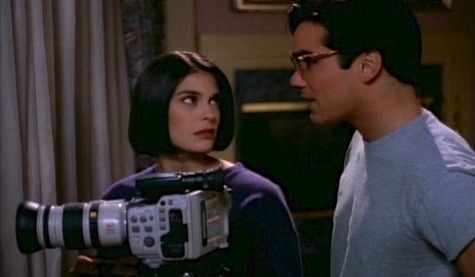
Creators: Jerry Siegel, Joe Shuster
Origin: Action Comics #1, 1938, DC
I don’t want to talk about the comic book version of Lois (especially not 52’d Lois…*angry grumbling*), but about her TV counterpart, specifically from The Adventures of Lois and Clark. Say what you want about the show, but I adore it immensely in large part because of Lois. She gets top billing, and the show makes it clear from the get-go that while Superman is the star Lois is most assuredly the lead. Teri Hatcher played her with the sort of sarcastic edge powerful women tend to develop in order to make it to the top of a male-dominated field. No one ever accuses Lois of sleeping her way to the top. No one would dare.
I was in middle school when Adventures was on the air, and as much as I loved the simmering romance between Lois and Clark, I idolized Lois. She was everything I wanted to be: tough, brilliant, fantastic at her job, respected and admired, unwilling to settle, and with an unquenchable desire to fight for the truth. And she had a great, worthy guy at her side, one who loved her just as she was, one who didn’t force her to acquiesce to him or play second fiddle, one who could rescue her from certain death and not make her feel like a damsel in distress. They were partners, a team, and I loved that. It was the first time I’d ever seen that in pop culture, and I’ve spent the entirety of my dating life trying to replicate that. And if I could have that while also being Ultra Woman, all the better.
Monica Rambeau and Carol Danvers
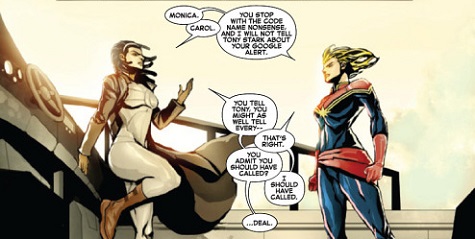
Aliases: Captain Marvel, Photon, Pulsar, Spectrum; Ms. Marvel, Binary, Captain Marvel
Creators: Roger Stern, John Romita, Jr.; Roy Thomas, Gene Colan
Origin: The Amazing Spider-Man Annual #16, 1982; Marvel Super-Heroes #13, 1968, Marvel
You didn’t really think you’d get through a whole women-centric post from me without talking about the Captains Marvel, did you? Wonder Woman, I can take or leave, but Monica and Carol are required reading in the Brown household. Carol, of course, ya’ll should know about by now. Back before she was Captain Whizz Bang, she was saddled with one of the worst comic book stories ever written for a woman, yes, even worse than “The Killing Joke.” In the 1980s she was brainwashed, raped, and impregnated, then basically abandoned by the Avengers when they let her be taken off to an alternate dimension by her rapist. Kelly Sue DeConnick rectified a lot of that terribleness by promoting Carol to Captain Marvel and adding in a bit of wibbly wobbly timey wimey mucking about to give her agency and self-determination in her own fate. And that’s Carol down to a T. Carol is kind, Tina Fey bossy, and a total badass. She doesn’t want to be tied down to someone else’s vision of how she should live her life. She wants to fly.
And then there’s Monica Rambeau. Marvel is supposedly going to give Carol her own movie one of these days (unless they push it back for yet another movie about a white dude), but frankly I’d rather have Monica on the silver screen. Or, even better, both of them kicking butt all over space. Like Carol, Monica is crazy powerful, but where the current Captain Marvel relies on dry humor, the previous Captain Marvel relishes in biting sarcasm. Call her a sassy Black friend or angry Black woman at your own risk. Iron Man once made the mistake of calling her “babe,” and had that line been written today I’m pretty sure she’d have knocked that tin suit right off him. She often combines her powers to convert her body to any form of energy on the electromagnetic spectrum with that of her superpowered teammates, but Monica never comes off as a sidekick. She’s far too confident in her abilities and self to ever let anyone reduce her to “the help.”
Suzie
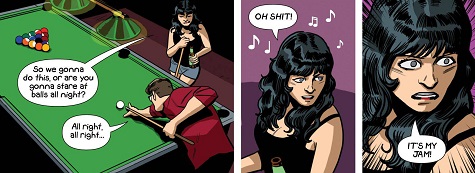
Creators: Matt Fraction, Chip Zdarsky
Origin: Sex Criminals #1, 2013, Image
Suzie and Jon are the sex-having, bank-robbing, pornshop-rearranging stars of Fraction and Zdarsky’s a-frakking-mazing comic book Sex Criminals. She is one of those characters who transcends ink and paper. Every woman has been Suzie at some point in her life. We’ve all been frustrated with our bodies and reveled in discovering all the exciting things they’re capable of. We’ve relied on the wrong people for sex ed because the right people won’t help (my church school’s sex ed came down to “You’ll die of AIDS if you kiss a boy” and passing around a piece of chocolate as a slut-shaming tool). We’ve fallen too hard and too fast, said “yes” to people who deserved a “no,” and had knock down drag out fights with our BFF triggered by a guy but really over something that’s been building for years.
As a librarian myself, I am automatically partial to librarians in my pop culture, especially when they are as cool as Suze. And by cool I mean complex and realistic. For a fictional character, she’s surprisingly realistic. Like, I’ve met people IRL that are faker than her. The great thing about her being so lifelike in her personality is that she’s flawed. She is about as perfect as your average real-world human, in other words, she’s got straight up issues. She makes mistakes and does stupid stuff. Sometimes she admits her faults, sometimes she doesn’t, sometimes she doesn’t care, and sometimes she doesn’t realize she’s in the wrong. But no matter what happens, she doesn’t sacrifice or compromise her sense of self. It took me until I was almost 30 to finally get comfortable with who I am as a person and my body. Suze got there a bit earlier than me, but it is so nice to stop fretting about what Cosmo thinks.
Tank Girl
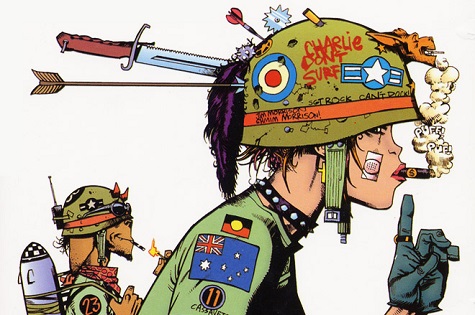
Alias: Rebecca Buck
Creators: Jamie Hewlett, Alan Martin
Origin: Deadline Magazine #1, 1988, Dark Horse
Tank Girl lives in post-apocalyptic Australia, like a bizarro absurdist Mad Max as hallucinated by a protest-enthusiast high on molly on the last night of Burning Man. Tank Girl, so named because she’s a girl who drives a tank, is friends with Sub Girl, Boat Girl, and Jet Girl. She’s in a committed relationship with a mutant kangaroo who used to design toys but now settles for doing everything his girlfriend tells him to do. She hangs out with talking stuffed animals named Camp Koala, Mr. Precocious, and Squeaky Toy Rat. She’s sexually frank, brutally honest, and oh so raunchy. I haven’t read nearly enough of Hewlett and Martin’s comic—I should really get on that—but the bits and pieces I have are just the best. Since her debut she’s been a feminist icon, counterculture inspiration, and all-around zeitgeist. Like Vampirella and genderbent couples outfits, there’s guaranteed to be at least one Tank Girl at every SFF con.
The Tank Girl movie came out way back in 1995, but it wasn’t until college in the early aughts that I was introduced to her during a drunken movie night in a friend’s dorm room. Mind totally blown. It’s a weird, weird movie so, of course, it and its soundtrack became the undercurrent of our college life, which was pretty perfect considering I went to an all-women’s college in the liberal bastion of sin that is the San Francisco Bay Area. Though I would never want to actually be her, I wish I had even a quarter of her bravado. Every woman could do with adding a splash of Tank Girl’s post-feminist anarchist streak to our personality.
Tulip O’Hare
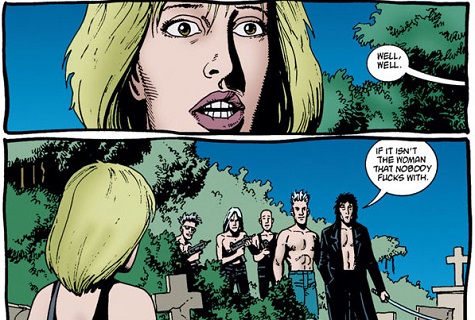
Creators: Garth Ennis, Steve Dillon, Glenn Fabry
Origin: Preacher #1, 1995, Vertigo
When I first got back into comics after more than a decade long hiatus, Preacher was one of the first few comics I bought. (Why Preacher? Because Yorick from Y: The Last Man had a lighter that said “Fuck Communism” on it, hence Jesse Custer.) Preacher was a steep hill to climb as a relative newbie, but totally worth it. Everything about that series was incredible and terrible and awe-inspiring and gag-inducing, but Tulip stole the show. She’s tough as nails, loyal as a dog, and sexy as hell. She’s the kind of woman who, when she needs to pay off a debt but can’t find legit work, decides that she’d rather be a hitwoman instead of a prostitute. Preacher is chockablock with grotesque violence and body parts being shot off in horrific ways, and a helluva lot of that is thanks to Tulip and her gunslinging skills.
Her father initially wanted a son, but after she was born he decided it wasn’t fair that women never got to do all the stuff men did so he set about teaching her right. She’s a master marksman, whip smart, devilishly liberal, and a staunch feminist by the time she meets Jesse, and those qualities keep him. It saves her best friend Amy, too, when she rescues her by nearly shooting her attempted rapists. Tulip is treated horrendously by both Jesse, the love of her life, and Cassidy, an asshole vampire, because it’s a graphic novel from the nineties and SJWs and social media weren’t invented yet, so there’s only so much you can do. She deserves better than getting turned into an alcoholic and drug addict because some dude she had the feels for ditched her repeatedly, but she nevertheless rises above it.
Velvet Templeton
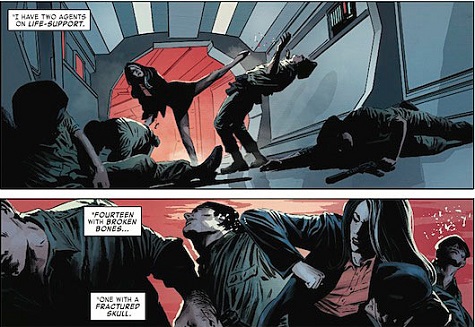
Creators: Ed Brubaker, Steve Epting
Origin: Velvet #1, 2013, Image
Everyone underestimates Velvet. To the male spies at ARC, she’s a sexpot who’s slept with just about every man on the force. To the ladies in the secretarial pool, she’s a diligent assistant who does her job better than anyone else and never makes waves. But she’s so much more than a Girl Friday or a Bond Girl. She was trained by one of the best women spies in WWII, and cut her teeth in the early days of the Cold War. Before she killed her husband for being a double agent over a decade before, she was one of the best spies in the agency, and even in her mid-forties she still kicks more ass than all of the men combined. Most of the young bucks in ARC don’t know about her past, and that makes her the most dangerous woman—person—on the planet when a mole frames her for the murder of one of her former lovers.
If you liked Agent Carter, you’ll love Velvet. She’s basically Peggy Carter turned up to eleven. Velvet is Peggy two decades down the line after she and Steve got married and he betrayed her by siding with the Nazis and tried to kill her. Where Peggy is forced to constantly deal with the misogynists in the SSR, Velvet is high ranking enough to get a modicum of respect. She hates her position, but can compartmentalize it in such a way that it doesn’t eat her alive. She’s tougher than Peggy, too, with a knack for brutal fighting. And like Peggy, when she needs help, she almost always turns to women who are just as overlooked as she is. The series is set in 1973, and her world is run by the axiom that behind every great man is an even greater woman with an axe to grind and a lot of pent up frustration. The female arms-dealer, the tortured cheating wife, and the kinky lesbian agent are quickly discarded or outright ignored by men, making them the perfect people to help Velvet figure out who set her up. A lesser graphic novel would have her look to her male superiors for help and leave her crying and distraught over her dead husband. Not Velvet. She’ll save herself, thank you very much, and take out every testosterone-addled jerk who gets in her way.
Alex Brown is an archivist, research librarian, writer, geeknerdloserweirdo, and all-around pop culture obsessive who watches entirely too much TV. Keep up with her every move on Twitter and Instagram, or get lost in the rabbit warren of ships and fandoms on her Tumblr.











Death.
Faith and Livewire (Valiant)
Abby in SLEEPY HOLLOW. (Which was renewed today! Yeah!)
EVERY female lead in PERSON OF INTEREST including Det. Carter (RIP), Shaw, and Root. POI is science fiction disguised as a action/adventure mystery.
Tambi Baker from Strangers in Paradise. A ruthless killer with a vulnerable streak, definitely not predictable.
@StrongDreams: I actually had the sisters on here initially (and Desire will probably turn up in my Pride Month post).
@templarsteel: I don’t read much Valiant, so I’ll have to check them out.
@MByerly: Oh, dude, I could talk about TV chicks for ages and ages. If you haven’t already, you should read the Sleepy Hollow comic book. Noelle Stevenson does a lot of the one-offs and some of the covers/variants. It’s pretty good.
@JaneW: Ooo…don’t know Strangers in Paradise. Adding to my list!
I also thought the TV Lois Lane was great, certainly the best portrayal of Lois in any media, at least in my humble opinion. And Terri Hatcher and Dean Cain had great chemistry. The show was often corny, but it worked quite well.
I also love the modern incarnation of Captain Marvel. Some of her earlier adventures are best left in the past, but this latest run is a lot of fun, some of the best space adventure Marvel has ever presented, with a lot of great interplay with other woman characters making the book a lot of fun.
I started buying Velvet because of the creative team, and the wonderful job they did on Captain America, but the character has been compelling enough for me to stay with it through its entire run. Great, gritty spy adventures with a heroine who takes no guff from anyone.
Since you opened the field to include TV characters, I would mention Ahsoka Tano, the padawan sidekick from Clone Wars who by the end of the series had grown into a pretty compelling character, and sidekick to no one. I was pleased to see her appear in the new Rebels series, and look forward to seeing her further adventures.
Most of the creators of the characters are men. Interesting…
So let me wade a pinky toe in before falling ass-first into the deep end:
a. a pull list would be having your favorite local comic book stores having issues of your favorite (or that hard to find/quickly sells out small print-run, etc. etc.) comic book so it doesn’t actually “hit” the sell floor. To be fair, we shouldn’t really be talking about television performances/tv shows, even if they are made into comics (after all, the comic book industry, following the lead of tv and film producers, is pretty much turning anything into a book, just recently releasing one for the failed X-Files spin-off Millenium.
b. Scott Lobdell is guilty of many, many things, from writing over-wrought, confusing and just-plain-stupid story arcs to ruining some decent to good comic books for the duration of his run, but he didn’t create Starfire (much less actually illustrate the version shown above). You should point your proverbial typewriter at two guys who are considered among the great men of letters, Marv Wolfman, and more specifically at artist (and POC) George Perez. On this point, the folks to really blame are the group editors at DC (which, likewise leads me to the edge of the swimming pool) ….
Lois is a troublesome icon for a number reasons; there’s longer, better written support for this elsewhere, but original formula (1938) showed her pretty much as you describe Teri Hatcher’s version: “tough, brilliant, fantastic at her job, respected and admired, unwilling to settle, and with an unquenchable desire to fight for the truth.” As with a live action version that pre-dates Hatcher, 1978’s cinematic Superman has Margot Kidder as ‘tough’ and ‘respected/admired.’ The DCAU Lois is similarly shown as pretty much every descriptor you used.
Not to take anything away from Hatcher; I was also a fan of the show and liked the portrayal. But back to the group editors at the comic book company, my opinion is that you can point to them – creators who are getting a paycheck essentially signed off by them are not going to stop doing things like some of the outfits in the ‘new 52’ if they aren’t able to make a living doing so. This post is getting long enough and, again, there’s plenty of intelligent examples of this elsewhere.
As for the current comic book version of Lois, I’d again point you to Grant Morrison’s 2011-12 run on Action Comics (which I suggested last month). While Lois is not a prominent feature, I suspect you would find her portrayal far more to your liking. Likewise, I would point you to the collected trade of Superman Unchained, it’s only 9 issues and Lois essentially plays the co-starring role (which is in no way a romantic/girlfriend or wife type) and, again, fits your descriptors to a tee.
Finally, Felicity does pre-exist in comic books – just not in a fashion anyone who’s a fan of her (or an Ollicity shipper) is going to be interested in. IMHO, your description is reminiscent of the way other shows can often be incorrectly read on the internet (Sterek is a perfect example, to point to something where folks believed the show was about one thing – Derek and Stiles versus its actual scripts). In Arrow‘s case, and I’m not a fan of the show, saying that Oliver is not heroic or ‘falls apart’ without her ignores all those relentless flashbacks that show us Ollie dealing with life (e.g. murder, survival, torture, etc.) prior to knowing her. Yes, I know many folks would massively disagree with me ….
@elen: Well, to be fair, most creators historically have been male. I don’t think being a man precludes the creation of awesome female characters – see SEX CRIMINALS – but it does also mean the likelihood that they’ll do something awful to her is much higher. Siegel and Shuster’s Lois Lane is nothing like Teri Hatcher’s take on her, so, to me it’s less important who made the female character first than what the rest of her “life” was like.
If it helps, my regularly scheduled Pull List (coming next week-ish) is all Kelly Sue DeConnick all the time.
Rob Liefeld’s “Glory” ends up leading to Joe Keatinge/Sophie Campbell’s “Glory” though
Totally agree about Felicity on Arrow – I certainly hope the CW and Arrow writers see what an amazing character they have on their hands so that they continue to do her justice. I also hope they see how critical she is to keeping Oliver’s head on straight. I’d love for ‘Olicity’ to be endgame on the show – Arrow is always at it’s finest when those two are interacting together!
@FDS: A) TinaFeyEyeRoll.GIF
B) I never claimed Lobdell created Starfire, but his version of her was atrocious. It was one of the worst parts of the New 52. I can be upset at Lobdell’s choices as well as DC’s, and yet none of that diminishes my love of Starfire the character…even though my vision of her is strictly from the TEEN TITANS cartoon. In fact, if in next year’s Women’s History Month post I use Starfire, I guarantee you the cartoon is the version I’m going to praise.
As for Lois Lane, I don’t think it’s necessary to read everything a character has ever been in to decide how I feel about them. I’ve not read her earliest runs, and have no interest in doing so. I tried to jump in at the New 52 and jumped right back out again. I’ll settle for Lois from ADVENTURES and from the late 90s/early 00s cartoons. I’m not sure I understand your last bit about paychecks and outfits, but I don’t think that some versions of a character are problematic that they undermine other versions. If that were true, no one could ever write any post about any character ever. I do have Morrison’s run on my To Read queue already, so on that we agree. I generally like him and his work a lot, so I’m looking forward to it.
As for Felicity, the reason I chose to talk about ARROW’s Felicity was in large part because not only do I love her truly, madly, deeply, but because the comic book version is not nearly as interesting. Olicity is most certainly canon in ARROW, so I’m not sure what your complaint is there.
The thing is, Oliver does fall apart. Just take last night’s ep. It’s Felicity who sets him on the right path. Everyone tells him not to become Ra’s Al Ghul, but it’s Felicity who he listens to. She keeps him human. Without her, he’s a killer. Without him, she gets by. Before her, Oliver isn’t dealing with any of his issues – again, they’ve made that explicitly clear in many eps, including last night’s – and she forces him to confront himself and decide what kind of man he wants to be. She triggers that. In the flashbacks, Oliver reacts to his environment. He takes up the green hood because other people told him to (remember when his dad told him to save the city?) Waller, Slade, and Ivo push him into dark personal territory and Oliver reacts with violence. Felicity is active. She chooses to use her tech skills for good. She chooses to join Oliver’s team. She chooses to help Ray. People ask her to do all kinds of things, but she never compromises her sense of self to do it. Oliver siding with Merlyn is precisely why Felicity left. When Oliver is presumed dead, Felicity stays strong (mourning him isn’t the same as falling apart and becoming less human). She’s the one that keeps the mission going, and she only gives up after Diggle and Roy do and she has no support base. Felicity makes Oliver a better man, but that’s all from Oliver’s perspective. Felicity just is who she is. It’s Oliver who is reacting to her. Her character exists beyond just a plot device for him because her character development isn’t reliant on him like his is (mostly) on her.
However, you bring up an intriguing though tangential point about fandom. Canon and shipping aren’t codependent states. Shipping often inspires fans to check out the source material – a good chunk of my pop culture consumption comes from stumbling upon ships on Tumblr and wanting to know what inspired the fics and fanart. No one watching ARROW is diving into the Green Arrow comics expecting Olicity, and no one coming from the comics should expect the same content on television. Shippers understand that not all ships are canon…we just don’t care. I can watch KINGSMEN and think it a fine but lazy movie then spend the next two weeks indulging in nothing but Hartwin fix-it fics. I’ve never played DRAGON AGE: INQUISITION, but I love me some Iron Dorian. Dean is so much more complex when he’s half of an AU Destiel than when he’s straight. I think Cartinelli is the best thing to come out of the MCU, with Peggy x Steve x Bucky D/s a close second. Not all ships are slash, and not all fics contain ships.
There are much bigger issues at play with shipping and fandom than can be dealt with in a comment section on a not-related post, so I’m going to wrap this up here. Yes, there is a minority of hardcore fans who are way too invested in their ships, but the same can be said about sports fans and comic book geeks. (Critics don’t like to make those comparisons, however, because shipping tends to be a primarily female activity.) Sterek and Destiel are problematic ships not because the fandom is fighting over whether or not they are canon or fanon (only a fraction are at war over it, not that there’s anything wrong with being passionate about the thing you love, but the rest of us are all), but because the shows queerbait the subjects of those ships.
FDS:
“a. a pull list would be having your favorite local comic book stores having issues of your favorite (or that hard to find/quickly sells out small print-run, etc. etc.) comic book so it doesn’t actually “hit” the sell floor.”
You do realize that “Pull List” is the name of this monthly column, yes? (Alex’s column will be a year old in July.) As such, I don’t think you need to explain and define what a pull list is. I’m pretty sure Alex *and* most of the reader’s already know.
I came here for Death. Thank you #1.
Tank Girl was a lovely boob-rocket attack from the past as well:)
Hmm, that sounds un-feminist, perhaps, but it had to be said nonetheless.
@AlexBrown,
I think you brought up an interesting point regarding Oliver. Do you think he’s almost too reliant on Felicity and Diggle at this point to the point where it’s unhealthy?
Loved what you wrote about Felicity. I feel like she’s been taking a lot of heat this season because she’s been a) more emotional b) being used to support other supporting characters’ stories like Ray Palmer c) has been butting heads with the male lead. So it’s nice to read something so wonderful about her character and how she’s only grown this season
@AlanBrown: Meant to reply to you ages ago. VELVET is one of those comics I just had to include on this post because not enough people know about her. There’s no reason it shouldn’t be one of the most popular comics from Image.
@MONOLITH: Glad Tank Girl tempted you to stay. Death is great, but if I had to pick a sister, Delight/Delirium.
@Marceyes, Littup: Oliver has always been too dependent on everyone in ARROW. He uses his codependency as a crutch to not have to look too deeply at the real reasons behind his behavior. If he did that then he’d have to start making active choices. By reacting to everything instead of making his own decisions, the only guilt he has to carry is from not being better than his enemies. If someone dies, it’s because Oliver couldn’t stop [insert Big Bad here], not because Oliver made the wrong choice.
As for Felicity, yes, she’s supportive of other characters, but I don’t think that makes her lesser. She’s evolved past being a character who exists solely as a sounding board for the rest. Dr. Snow on THE FLASH is still stuck in that rut, as is Iris West. Laurel on ARROW had absolutely no reason to exist outside of Oliver until she became Black Canary, and even now I think her role is tenuous. Hell, even Roy is pretty meaningless in the large scheme of things. But Felicity’s support comes from her personality. She is more than a sounding board.
Oliver doesn’t just talk at her and then come to a decision. He wants her opinion, needs it in fact, and she gives it freely. She isn’t always right, and a lot of time she lets her emotions get the best of her, but that’s human, isn’t it? And all of that is thanks to Rickards. In lesser hands, she’d be as flat as most of second tier women characters in comic books. And to be fair, Ollie and Ray are most assuredly wrong in their behavior. Ray uses his wife’s death as much as a crutch as Ollie uses his parents and Tommy. Felicity is right when she said his wife wouldn’t want him risking his life because of her. That takes all responsibility off Ray and puts it onto the dead wife, and that’s not fair. Felicity doesn’t allow either man to shift their responsibilities onto her, which creates friction. Kudos to Felicity for that.
@AlexBrown,
Your analysis of Felicity is pretty amazing! I wish I could see you debate with this woman who wrote an article about “How Arrow Failed Felicity Smoak” a little while back on badassdigest.com. She essentially simplified all of Felicity’s issues by reducing her character to “a woman scorned”.
While I do agree that Felicity is a supportive character, I just hope that she gets her own story line that enriches her own arc/characterization in season 4. I think it’s about time we got that. I hope the story about her elusive father is a juicy one. Rumor has it that he’s tied to HIVE, so Diggle will have a piece of the action too which is exhilerating.
Your response was such a pleasure to read :)
@Littup: I get where people are coming from with their Felicity hate, but I don’t buy it. It’s like people who snark on Sansa because she’s not Arya or Dany. Sansa is arguably the most powerful person in GoT – that teenage girl has, entirely on her on, survived Cersei, Joffrey, Baelish, Tyrion, the murders of most of her family, etc. And she does it by manipulating in the background.
At this point, Felicity is basically Oracle (speaking of which, you should totally check out BIRDS OF PREY for more awesome women superheroes). Ra’s may have unlimited resources, but sic Felicity on him and he’ll be down and out in a matter of hours. Yes, the show could and should be using her more, and too often her subplots revolve around romance, but then they have that great (Bechdel approved!) scene where Black Canary tries to teach her how to fight. The show itself isn’t very good at dealing with Felicity, but that’s more than made up by Rickards herself.
I dunno, I guess I’m just defensive over her. I hate when people slam on a female character for not being a Strong Female Character TM. She’s strong in a real way, not in a TV trope way.
I totally second “Strangers in Paradise”. There are a lot more strong women in there than just Tambi – Katchoo is pretty amazing (even if she started as a victim), Mrs. Parker is just completely evil and all here girls are absolutely kickass. I also would like to add Alan Moore’s Promethea. That one actually shows the growing emancipation of its main character, there are several earlier incarnations of Promethea which are clearly just projection screens for male fantasies, but the later ones are soooo over that… Another one I can think of is Sara in “Knights of the Dinner table” (for those who like roleplaying comics). She’s clearly the most intelligent and least neurotic member of the group, and usually ends up having the upper hand.
@AlexBrown
I ADORE Sansa. She’s the epitome of strength and I hate how people don’t understand where she’s coming from. Sansa plays the game without ever really compromising her beliefs or who she is. She survives using her femininity, and no matter how many times she’s beaten down, that doesn’t stop her from giving up. Arya has an obvious strength. But Sansa’s strength is more implicit, which in my opinion is more dangerous.
Regarding Felicity, I haven’t been buying her friendship with Laurel. It seems rather one sided to me which is kind of sad (I hope this changes though). Then again, Laurel has been portrayed as rather narcissistic this season so this doesn’t really surprise me (my issues with Laurel’s characterization are abundant, but I don’t think this is the place for Laurel criticism so I’ll move on).
I’m intrigued by the possibility of Felicity and Thea striking up a friendship though. And I’d love for Lyla to be a part of the fold more. Her interaction with Oliver in the Flash/Arrow crossover was pretty great. I hope the show explores these friendships more in the future.
I thoroughly believe that Felicity wouldn’t have been a successful character if it wasn’t for Rickards. She elevates the material she’s been given with her subtle nuances and vulnerability. Rickards simply owns this role and I love how the writers are giving her more content and stretching out her character even more.
And you’re right. Felicity shows a different kind of strength that juxtaposes Oliver’s strength quite well. She doesn’t kick ass, but she has an emotional and mental strength which a lot of characters on the show (Laurel, Oliver, and Ray) rely on. To say Felicity has been reduced to a whiny/bitchy woman would be quite fallacious and ignoring everything she’s been through. In the end–and I think a lot of people usually forget this fact because of the genre of the show– she’s human who’s dealt with a lot this season.
As you may have noticed, I get kind of defensive of Felicity too
Been sick so sorry about the bit of delay.
@13, no, I saw the post last month for the African-American comic book characters, which I participated in, and referenced this – so, no, even though I’ve been hitting this site for a good two years now, I was not aware it was the name of a regular column by Alex. That said, I would presume she (or the site editorial staff) named it such on the basis of what a pull list is for comic book readers, comic book buyers and for comic book stores.
That, more than anything else, was my main issue with the inclusion of Lois and Felicity from a TV show. There’s no comic book to point people to, to suggest that they check out. I would be totally in favor of an essay (or two/more) on the portrayals of females in the superhero genre in live action and animated products. That is something we consume, so in a sense, a ‘pull list’ pointing folks to representations that are new (to them) would be an interesting discussion.
DC put out an entire book, hard cover prestige format in 2013 for Lois during the 75 anniversary for Superman (as it was also, in fact, hers given her appearance in that initial 1938 Action Comic) – and, in addition to Morrison, I would see if your local library has Unchained, it really has a great Lois story, the clothes/locales are emphasize a strong/heroic aspect I believe you’d appreciate. I would point you to the third paragraph of this review on one of the 9 issue of this miniseries and this pull from an issue.
I meant that the artist, even if they would be well-intentioned otherwise in art work or script on a comic book, still have their paychecks signed off by the editors and higher-ups at DC; as a guy, I think there’s a lot of troublesome outfits for it being 2011 when the Nu52 reboot was launched, and given that the two co-publishers have been talking for over a month about how diverse and representative (as to females and race, amongst other aspects), there’s a history behind some poor choices, editorially, at DC, that I don’t think it’s possible to point simple at how Lobdell wrote Teen Titans (poorly) or anything else he’s written (generally badly) for DC in the reboot. TL;dr my point is the PTB are far more to blame. See here for a good discussion in that regard.
As far as Arrow, to be fair to you, I do not watch the show. I did happen to catch this week’s episode and I see your point and, you may be more accurate over two seasons, but when I do catch an episode (as with the two Flash back door pilot episodes from last season, which I did watch) and the little I caught of the first season, I’d stand by my comments that Ollie can fail or rise on his own, and its my understanding that he’s pretty much had a sexual relationship with everyone on the show save Roy and Diggle (and his sister).